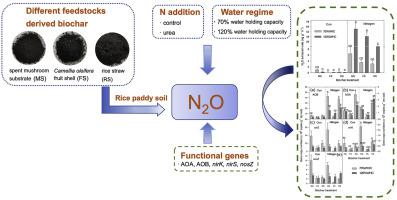当前位置:
X-MOL 学术
›
Environ. Pollut.
›
论文详情
Our official English website, www.x-mol.net, welcomes your
feedback! (Note: you will need to create a separate account there.)
Rice straw biochar mitigated more N2O emissions from fertilized paddy soil with higher water content than that derived from ex situ biowaste.
Environmental Pollution ( IF 7.6 ) Pub Date : 2020-04-04 , DOI: 10.1016/j.envpol.2020.114477 Xintong Xu 1 , Chang He 1 , Xi Yuan 1 , Qiang Zhang 1 , Shuli Wang 1 , Baihui Wang 1 , Xiaomin Guo 1 , Ling Zhang 1
Environmental Pollution ( IF 7.6 ) Pub Date : 2020-04-04 , DOI: 10.1016/j.envpol.2020.114477 Xintong Xu 1 , Chang He 1 , Xi Yuan 1 , Qiang Zhang 1 , Shuli Wang 1 , Baihui Wang 1 , Xiaomin Guo 1 , Ling Zhang 1
Affiliation

|
Biochar could mitigate greenhouse gas emissions, especially nitrous oxide (N2O). Effects of interactions between different biochar and water content on N2O emissions from rice (Oryza sativa L.) paddy soils have not been thoroughly understood. We evaluated effects of different biochar (derived from Camellia oleifera fruit shell, FS; spent mushroom substrate made of Camellia oleifera fruit shell, MS; rice straw, RS; at the rate of 40 g kg-1) and water contents (70% and 120% water holding capacity, WHC) on N2O emissions from rice paddy soil fertilized with nitrogen (N, 0.2 g kg-1), and examined microbial functional genes associated with N2O emissions to understand the underlining mechanisms. The results showed that RS biochar was higher in pH, available N, dissolved organic N, and decreased more N2O emissions from soils with N and 120% WHC treatment relative to MS and FS biochar (by 363% and 200%, respectively). Although RS biochar potentially increased the abundance of ammonia-oxidizing archaea amoA gene (AOA), changes in functional gene abundance did not concur with decreases in N2O emissions. Instead of changes in microbial communities, the relatively higher pH as well as lower available N and dissolved organic C and N of RS biochar could have contributed to the decrease in N2O emissions compared with MS and FS biochar. Thereby, the in situ application of rice straw via biochar could be considered in the mitigation of N2O emissions from fertilized rice paddy soil instead of biochar derived from ex situ feedstock.
中文翻译:

稻草生物炭减少了来自水分含量更高的施肥水稻土的N2O排放,其排放量高于异地生物垃圾。
生物炭可以减轻温室气体的排放,特别是一氧化二氮(N2O)。尚未完全了解不同生物炭和水分之间的相互作用对水稻(Oryza sativa L.)稻田土壤N2O排放的影响。我们评估了不同生物炭(来自油茶果壳FS;由油茶果壳MS制成的废蘑菇基质;稻草RS);以40 g kg-1的比率)和水分含量(70% 120%的持水量(WHC)对施以氮(N,0.2 g kg-1)的稻田土壤N2O排放的影响,并研究了与N2O排放有关的微生物功能基因,以了解其下调机理。结果表明,RS生物炭的pH值较高,有效氮,溶解有机氮,相对于MS和FS生物炭,经NHC和120%WHC处理的土壤中N2O排放量减少了(分别减少了363%和200%)。尽管RS生物炭可能会增加氨氧化古细菌amoA基因(AOA)的丰度,但功能基因丰度的变化与N2O排放的减少并不一致。与MS和FS生物炭相比,相对较高的pH值以及相对较低的pH值以及较低的可用N以及RS生物炭的溶解有机碳和N可能有助于减少N2O排放。因此,可以考虑通过生物炭原位施用稻草来减轻施肥的稻田土壤中的N2O排放,而不是使用来自异地原料的生物炭。尽管RS生物炭可能会增加氨氧化古细菌amoA基因(AOA)的丰度,但功能基因丰度的变化与N2O排放的减少并不一致。与MS和FS生物炭相比,相对较高的pH值以及相对较低的pH值以及较低的可用N以及RS生物炭的溶解有机碳和N可能有助于减少N2O排放。因此,可以考虑通过生物炭原位施用稻草来减轻施肥的稻田土壤中的N2O排放,而不是使用来自异地原料的生物炭。尽管RS生物炭可能会增加氨氧化古细菌amoA基因(AOA)的丰度,但功能基因丰度的变化与N2O排放的减少并不一致。与MS和FS生物炭相比,相对较高的pH值以及相对较低的pH值以及较低的可用N以及RS生物炭的溶解有机碳和N可能有助于减少N2O排放。因此,可以考虑通过生物炭原位施用稻草来减轻施肥的稻田土壤中的N2O排放,而不是使用来自异地原料的生物炭。与MS和FS生物炭相比,RS生物炭的相对较高的pH值以及较低的可用N和溶解的有机C和N可能有助于减少N2O排放。因此,可以考虑通过生物炭原位施用稻草来减轻施肥的稻田土壤中的N2O排放,而不是使用来自异地原料的生物炭。与MS和FS生物炭相比,RS生物炭的相对较高的pH值以及较低的可用N和溶解的有机C和N可能有助于减少N2O排放。因此,可以考虑通过生物炭原位施用稻草来减轻施肥的稻田土壤中的N2O排放,而不是从异地原料获得的生物炭。
更新日期:2020-04-20
中文翻译:

稻草生物炭减少了来自水分含量更高的施肥水稻土的N2O排放,其排放量高于异地生物垃圾。
生物炭可以减轻温室气体的排放,特别是一氧化二氮(N2O)。尚未完全了解不同生物炭和水分之间的相互作用对水稻(Oryza sativa L.)稻田土壤N2O排放的影响。我们评估了不同生物炭(来自油茶果壳FS;由油茶果壳MS制成的废蘑菇基质;稻草RS);以40 g kg-1的比率)和水分含量(70% 120%的持水量(WHC)对施以氮(N,0.2 g kg-1)的稻田土壤N2O排放的影响,并研究了与N2O排放有关的微生物功能基因,以了解其下调机理。结果表明,RS生物炭的pH值较高,有效氮,溶解有机氮,相对于MS和FS生物炭,经NHC和120%WHC处理的土壤中N2O排放量减少了(分别减少了363%和200%)。尽管RS生物炭可能会增加氨氧化古细菌amoA基因(AOA)的丰度,但功能基因丰度的变化与N2O排放的减少并不一致。与MS和FS生物炭相比,相对较高的pH值以及相对较低的pH值以及较低的可用N以及RS生物炭的溶解有机碳和N可能有助于减少N2O排放。因此,可以考虑通过生物炭原位施用稻草来减轻施肥的稻田土壤中的N2O排放,而不是使用来自异地原料的生物炭。尽管RS生物炭可能会增加氨氧化古细菌amoA基因(AOA)的丰度,但功能基因丰度的变化与N2O排放的减少并不一致。与MS和FS生物炭相比,相对较高的pH值以及相对较低的pH值以及较低的可用N以及RS生物炭的溶解有机碳和N可能有助于减少N2O排放。因此,可以考虑通过生物炭原位施用稻草来减轻施肥的稻田土壤中的N2O排放,而不是使用来自异地原料的生物炭。尽管RS生物炭可能会增加氨氧化古细菌amoA基因(AOA)的丰度,但功能基因丰度的变化与N2O排放的减少并不一致。与MS和FS生物炭相比,相对较高的pH值以及相对较低的pH值以及较低的可用N以及RS生物炭的溶解有机碳和N可能有助于减少N2O排放。因此,可以考虑通过生物炭原位施用稻草来减轻施肥的稻田土壤中的N2O排放,而不是使用来自异地原料的生物炭。与MS和FS生物炭相比,RS生物炭的相对较高的pH值以及较低的可用N和溶解的有机C和N可能有助于减少N2O排放。因此,可以考虑通过生物炭原位施用稻草来减轻施肥的稻田土壤中的N2O排放,而不是使用来自异地原料的生物炭。与MS和FS生物炭相比,RS生物炭的相对较高的pH值以及较低的可用N和溶解的有机C和N可能有助于减少N2O排放。因此,可以考虑通过生物炭原位施用稻草来减轻施肥的稻田土壤中的N2O排放,而不是从异地原料获得的生物炭。











































 京公网安备 11010802027423号
京公网安备 11010802027423号